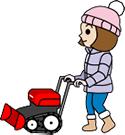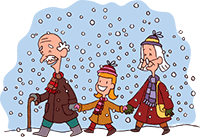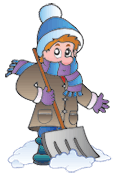Create a Management Plan for Driving Safety
- Assign a key member of the management team, such as the safety and health professional, responsibility and authority to set and enforce a comprehensive driver safety policy.
- Set and enforce mandatory seatbelt use.
- Don't require employees to drive irregular hours or far beyond their normal working hours.
- Don't require workers to conduct business on a cellphone or text while driving.
- Develop work schedules that allow employees to obey speed limits and to follow applicable hours-of-service regulations.
Road Safety
Equip each vehicle with a winter storm kit that includes blankets, a flashlight, cellphone with charger and extra batteries, a shovel, first-aid kit, non-perishable food, extra warm clothes and a water container.Before Driving
- Remove any snow on your vehicle's windows, lights, brake lights, roof and signals.
- Wear a seatbelt and properly restrain children in the back seat of a vehicle.
- Don't be distracted while driving. Many states prohibit texting while driving. For all drivers, distracted driving is deadly even in good weather. One study showed that 85 percent of crashes occur within 3 seconds of a driver's distraction; sending a text message while traveling 40 mph can cause your eyes to be off the road for 4.7 to 5.0 seconds, enough time to travel up to 294 feet before you start braking.
- Don't speed.
- Brake early, brake slowly, brake correctly and never slam on the brakes. If you have anti-lock brakes, press the pedal down firmly and hold it. If you don't have anti-lock brakes, gently pump the pedal.
- Beware of black ice. Roads that seem dry actually may be slippery and dangerous, so take it slow when approaching intersections, off-ramps, bridges or shady areas.
Snowblowing Safety
Never stick your hands or feet in the snowblower. If snow becomes too impacted, stop the engine and wait at least five seconds. Use a solid object to clear wet snow or debris from the chute. Beware of the recoil of the motor and blades after the machine has been turned off.Tips to Prevent Injuries While Removing Snow
- Check with your doctor. Because this activity places high stress on the heart, speak with your physician first. If you have a medical condition or do not exercise regularly, consider hiring someone to remove the snow.
- Dress appropriately. Light, layered, water-repellent clothing provides both ventilation and insulation. It also is important to wear the appropriate head coverings, as well as mittens or gloves and thick, warm socks. Take a break if you feel yourself getting too hot or too cold.
- See what you are shoveling/snowblowing. Make sure that your hat or scarf does not block your vision. Avoid falls by wearing shoes or boots that have slip-resistant soles.
- Clear snow early and often.
- Warm up your muscles. Shoveling can be a vigorous activity. Before you begin, warm up your muscles for 10 minutes with light exercise.
- Pace yourself. Take frequent breaks and replenish fluids to prevent dehydration.
Walking in Snow and Ice
Walk slowly and deliberately and wear boots or other slip-resistant footwear.Cleaning Up After a Winter Storm
About the Author

Sandy Smith
Sandy Smith is the former content director of EHS Today, and is currently the EHSQ content & community lead at Intelex Technologies Inc. She has written about occupational safety and health and environmental issues since 1990.
Sign up for our eNewsletters
Get the latest news and updates




